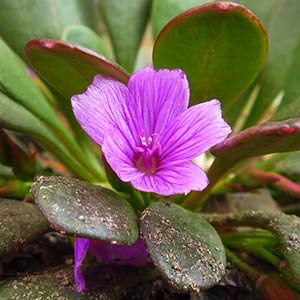Claytonia megarhiza
(synonym of Claytonia megarhiza var. nivalis)
Claytonia rosea
alpine springbeauty
Madrean springbeauty, Rocky Mountain Spring beauty, western springbeauty
5–25 cm.
2–15 cm.
basal leaves sessile, dilated at base into broad, succulent sheath, blade rhombic to oblanceolate, 2–10 × 0.4–2.8 cm, apex obtuse;
cauline leaves sessile, blade oblanceolate, 2–10 × 2–5 mm.
basal leaves sometimes absent, petiolate, blade linear to narrowly spatulate, 1–7 × 0.4–2 cm, apex acute to obtuse;
cauline leaves petiolate, blade linear, 2–5 cm, apex acute to obtuse.
multibracteate;
bracts subtending pedicels, apex obtuse.
multibracteate, rarely 1-bracteate;
proximalmost bract leaflike, distal bracts reduced to membranous scales.
12–20 mm diam;
sepals 6–8 mm;
petals white, pink, or rose, 5–20 × 3–8 mm;
ovules 6.
8–14 mm diam.;
sepals 3–5 mm;
petals pink, rose, or magenta, 8–10 mm;
ovules 6.
2–3 mm diam., shiny and smooth;
elaiosome 1 mm or less.
2–3 mm, shiny and smooth;
elaiosome 1–2 mm.
= 12, 16, 24, 32, 34, 36.
= 16.
Claytonia megarhiza
Claytonia rosea
Claytonia rosea is morphologically distinct from C. lanceolata based on early cytological and ecological study of the two species by D. K. Halleck and D. Wiens (1966) and the author’s review of type material.
(Discussion copyrighted by Flora of North America; reprinted with permission.)
- Local floras:
BC,
CA,
OR,
WA
- Local Web sites:
CalFlora,
CalPhotos,
Flora NW,
PNW Herbaria,
SW CO Wildflowers
WildflowerSearch
iNaturalist (observations)
USDA Plants Database
- LBJ Wildflower Center
- SEINet
- Plants of the World Online
- Encyclopedia of Life
- Wikipedia
- Google Image Search


